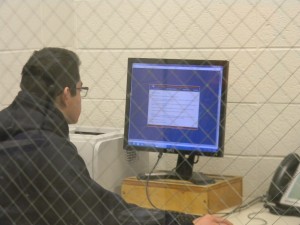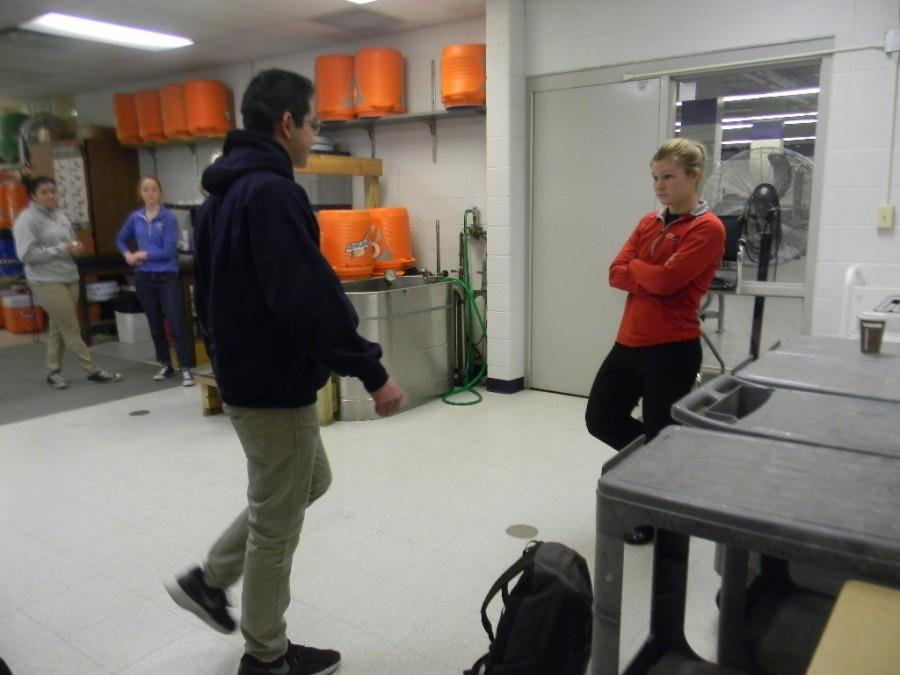Football and soccer pose highest risk for concussions
Photo by Emily Wissemes
Freshman Armando Lopez getting tested for a concussion after a baseball injury by athletic trainer Heather Cisowski. Dizziness can be a symptom of a concussion.
March 2, 2016
Almost no sport is free of a concussion hazard.
A concussion, also known as a mild traumatic brain injury, is caused by an impact to either the head or the body that causes the brain to move rapidly inside the skull.
According to the Sports Concussion Institute, a concussion may cause multiple symptoms. Many symptoms appear immediately after the injury, while others can develop over the following days or weeks.
Headaches and dizziness are most commonly reported. Other symptoms may include difficulty concentrating, nausea, lack of energy, fatigue, blurred vision, sensitivity to light and sound, and poor sleep.
“We have seen at least 20 concussions this school year alone and the year hasn’t even ended. Most come from football, soccer, and even cheerleading,” school nurse Annette Snyder said.
The Institute of Medicine and the National Research Council of the National Academy of Sciences reported in 2012 that football players sustained the most concussions among high school age athletes.
“I have had five that have been diagnosed by a certified professional. Two of them were mild and three were minor. The feeling is very weird, it’s weird on your brain, painful headaches, also dizziness and nausea, and blurred vision. Some lasted a week, others a month, the most recent one took about a month,” sophomore Jake Ullman said.
Ullman received a concussion from baseball, two from football, one from basketball and one from whiplash.
Among girls, soccer is associated with the highest risk, according to the National Academy Academy of Science Study. Contact with another player was by far the most frequent cause of concussions among female and male players, according to the study.
In 2015, freshman Grace Ramirez was at a soccer tournament when she sustained a concussion. She was going to shoot when another girl fouled her.
“When I went down she completely missed the ball and hit my head instead. I remember feeling like someone was splitting my head with an axe and I couldn’t stop vomiting,” Ramirez said.
Along with soccer, Ramirez also plays tennis.
“Since it happened during tennis season, I was out from both sports for about two weeks. When I’d go and sit and watch tennis practice, I remember just the sound of the tennis ball hitting the chainlink fence made my head hurt really badly,” Ramirez said.
Soccer seems to present more risks, but even helmeted sports are dangerous.
“The impact test is an online test that looks at their memory, concentration, balance and also their brain function. It basically sees if their brain is functioning normally or not. And from there it shows us if they are diagnosed with a concussion or not,” school athletic trainer Heather Cisowski said.
According to IHSA, on Aug. 3, 2015, Governor Rauner signed legislation that focuses on concussion management at the middle and high school levels which requires all schools in Illinois to follow when a concussion is suspected.
“If a student sustains a blow to the head during a sport they are taken to the sidelines and checked by the athletic trainer, who then decides if the student can re-enter the sport or (game) at that time,” Snyder said.
If the student has signs of a concussion, they are then advised to see their doctor before returning to sports or PE.
Following protocol after getting hit in the head with a baseball, freshman Armando Lopez, also Wildcat Chronicle reporter, went to Cisowski to get checked for a concussion.
Cisowski had Lopez balance on on foot, touch the tip of his nose, then take the impact test.

All new athletes are required to take the concussion test to compare to after a hard hit to the head.
“She said that everything else seems normal except the part with the squiggly lines. She thought it was red flag. She called my mom and told her I might want to go to the doctor to get checked,” Lopez said.
As far as school participation, “The doctor usually recommends limited screen time, extra time on tests and homework, and rest in the nurse’s office, if needed. If symptoms come back they should go back to their doctor ASAP,” Snyder said.






